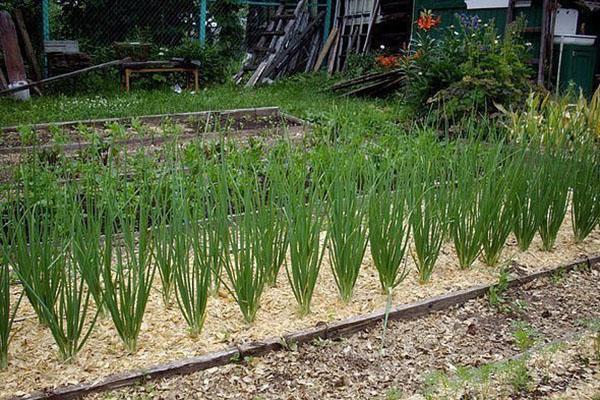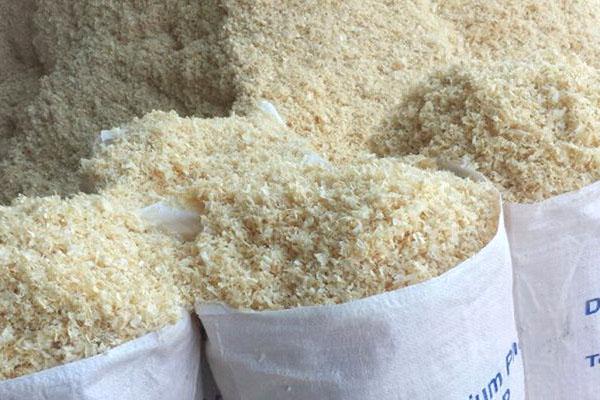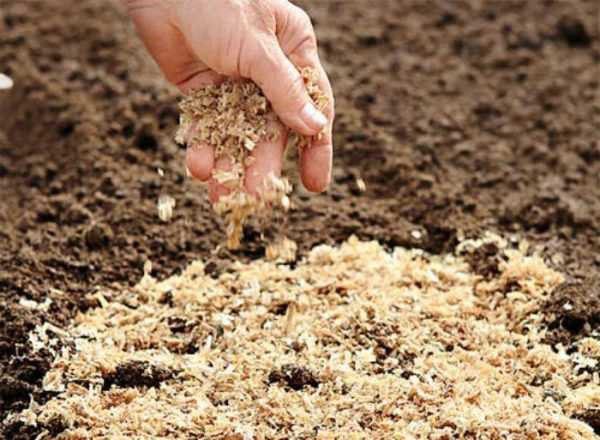How to use sawdust in your garden and vegetable garden to get a good result

During construction, procurement of firewood or the production of carpentry at the summer cottage, a lot of sawdust accumulates, which, due to the lack of practical use, are sent straight to recycling. It is important to know how to use sawdust in the garden and garden, what methods of using this cheap natural material in a summer cottage bring the maximum effect.
Properties and characteristics of natural wood sawdust

Fresh sawdust contains chemical elements:
- up to 50% carbon;
- about 45% oxygen;
- 4.4 to 4.9% hydrogen;
- 0.1% nitrogen.
1 m3 sawdust, on average, contains up to:
- 0.15 kg potassium;
- 0.25 kg of calcium;
- 0.02 kg nitrogen;
- 0.03 kg of phosphorus.
The competent use of sawdust in the garden will increase the level of elements necessary for the growth and nutrition of plants in the soil.
The use of sawdust allows:
- Make the soil looser and more breathable.
- Refuse additional loosening due to the absence of a soil crust.
- Reduce the amount of weeds in the beds.
- Preserve precious moisture in the soil.
The use of sawdust without additional processing is allowed only to cover row spacings, near-trunk circles and soil areas free of vegetation. Layer thickness 6-8 cm.

When it gets into the ground, wood waste with the help of soil microflora begins to actively decompose.
A number of problems arise from this:
- In the process of decomposition of hemicellulose, there is a significant decrease in the level of nitrogen and phosphorus in the soil.
- ABOUT
- coniferous saws in their composition contain a large amount of resinous substances that slow down the development of most plants.

To solve the first problem, the impregnation of sawdust with mineral fertilizers, and specifically with a solution of urea, will help.
Do not use softwood shavings as mulch and fertilizer.
When using wood waste in the garden and in the garden, most owners of summer cottages are interested in whether sawdust acidifies the soil? The answer is yes, they acidify and very noticeably. If this material is used incorrectly, be prepared for the fact that on your land plot the yields of vegetable, fruit and ornamental crops will significantly decrease.
This problem is relatively easy to solve. So how to deoxidize sawdust? Before use, it is necessary to soak the chips with an alkaline solution, for example, sodium nitrate. As a deoxidizer, you can use superphosphate, regular chalk, lime, ash or dolomite flour.

It is important to understand that the introduction of sawdust into the soil before winter will not give positive results, except for improving its structure, without additional processing of the material with specialized nitrogen EM-preparations, which will accelerate the roasting of sawdust and neutralize the negative effect on the soil.
How to use sawdust in the garden and vegetable garden: common uses
The use of shavings is not limited to improving the structure of the soil. Consider the simplest and most effective ways to use this material in your summer cottage.
As mulch

Wood shavings can be very successfully used as an excellent covering material for vegetables and garden plants. Sawdust as mulch: pros and cons.

Advantages:
- the ability to retain moisture in the soil;
- significant reduction in the amount of weed in the beds and in the aisles;
- properties to prevent overheating and freezing of the soil;
- good aeration of the soil;
- cheapness of the material.

The disadvantages of using fresh material are described above: acidification, depletion of soil nutrients, the need for time for the maturation of the mulching material.

Sawdust mulch is made as follows: a bucket of material will require 0.2 kg of calcium nitrate (urea) and 10 liters of water. Mix sawdust with urea for mulching, fill with water and cover with foil. After 14-20 days, garden soil and wood or peat ash should be added to the composition. After this procedure, the excellent covering material is ready for use.

Over-matured sawdust for the garden can be used immediately without preparatory measures.
As compost

Despite its negative properties, sawdust is successfully used as the main component of compost.
There are three options for composting:
- Sawdust and mineral.
- Sawdust-organic.
- Mixed.
To create sawdust-mineral compost you will need:
- pine sawdust in the amount of 50 kg;
- 1.5KG urea;
- 400 g double superphosphate;
- 750 g of potassium sulfate.
Dissolve mineral components in water, soak with sawdust solution, fold for maturation in a compost container. The compost maturation process takes 3 to 6 months.
Stir regularly during fermentation for better air access.
Birch sawdust as a fertilizer can be used to create sawdust-organic compost. To do this, mix 1 m3 sawdust from 100 kg of manure. If used chicken droppings, then 10 kg of organic matter will be required for a cubic meter of material. The composition should be put into a compost heap for fermentation, which lasts from 6 months to a year.
To obtain high-quality organic compost, periodically moisten the composition with water.

Pure oak sawdust in the garden emit substances that inhibit the growth of some crops. This is why they are best used to create mixed compost.
The technology involves two stages:
- Creation of sawdust-mineral compost on the basis of the oak component.
- After 30-40 days, add manure to the composition in a 1: 1 ratio.
The complete fermentation time of the mixed compost is 6 months.
All types of composts are best placed for maturation in early spring. In the fall, sawdust will completely lose all their negative properties of impact on the soil. Fertilizers laid in the spring can be used in a month. This is not yet a complete compost, but already a completely safe material that will improve the structure of the soil and fill it with nutrients.
The technology for creating the correct compost takes a long time to ferment the composition. Summer residents practice quick compost from sawdust. To do this, lay in layers: sawdust and earth in a well-drained pit. Each layer of sawdust is treated with an EM-preparation (Baikal). Such a "storage" must be covered with a film to create the most favorable temperature regime for rapid maturation. The fertilizer will be ready for use in 30-60 days.
Sawdust as a growing substrate

Prepared wood waste is very often used as a substrate for growing some plants. So, what can be grown in sawdust at their summer cottage? A great way to use sawdust for growing cucumber and tomato seedlings.
The landless method allows a young plant to develop a good root system in a short time. When using this technology, the maximum germination rate is achieved.
This will require a box and clean, decontaminated wood sawdust. The material should be doused with boiling water to destroy pathogenic microorganisms and pests, and then lay it out with a layer of 10 cm. Prepared seeds are laid out on sawdust and covered with wet wood chips.The entire structure is covered with a film. After sprouting, the film must be removed and the container moved to the light.

Another option for using sawdust is growing mushrooms. The substrate is prepared from hardwood sawdust and straw in a 3: 1 ratio. All components are soaked in boiling water for 5-6 hours, after which the mass is wrung out and stacked in layers in a plastic bag. The mycelium of the mycelium is introduced between the layers. Holes for mushrooms are created in the bag. After 40 days, you can harvest.
Sawdust for creating garden paths

Fresh sawdust is an excellent material for decorating your own plot. Wood chip paths have a lot of advantages:
- ease of creation;
- low material cost;
- small labor costs;
- high moisture permeability.
To make a path from sawdust, you need to make a trench 20-25 cm deep, then fill it with shavings and compact it thoroughly. The disadvantage of this design is the gradual shrinkage of sawdust, which should be added periodically. On the other hand, rotten sawdust will act as fertilizer, and the fresh layer will inhibit the growth of weeds.

Considering how to use sawdust in the garden and vegetable garden, one cannot ignore several common ways of using this material in a summer cottage:
- Sawdust of birch, alder, oak, as well as most fruit trees, is used as a material for smoking products. The optimum humidity is 50-60%.
- Sawdust can be used to make fuel cells - pellets.
- Dry sawdust has a low thermal conductivity, which makes it possible to use this material as a heater.
- Decontaminated and dried shavings are used as filling for vegetables and fruits during long-term storage.
The production of sawdust concrete from sawdust - a durable and warm building material that is used for the construction of capital residential and utility structures - is very popular with domestic summer residents.